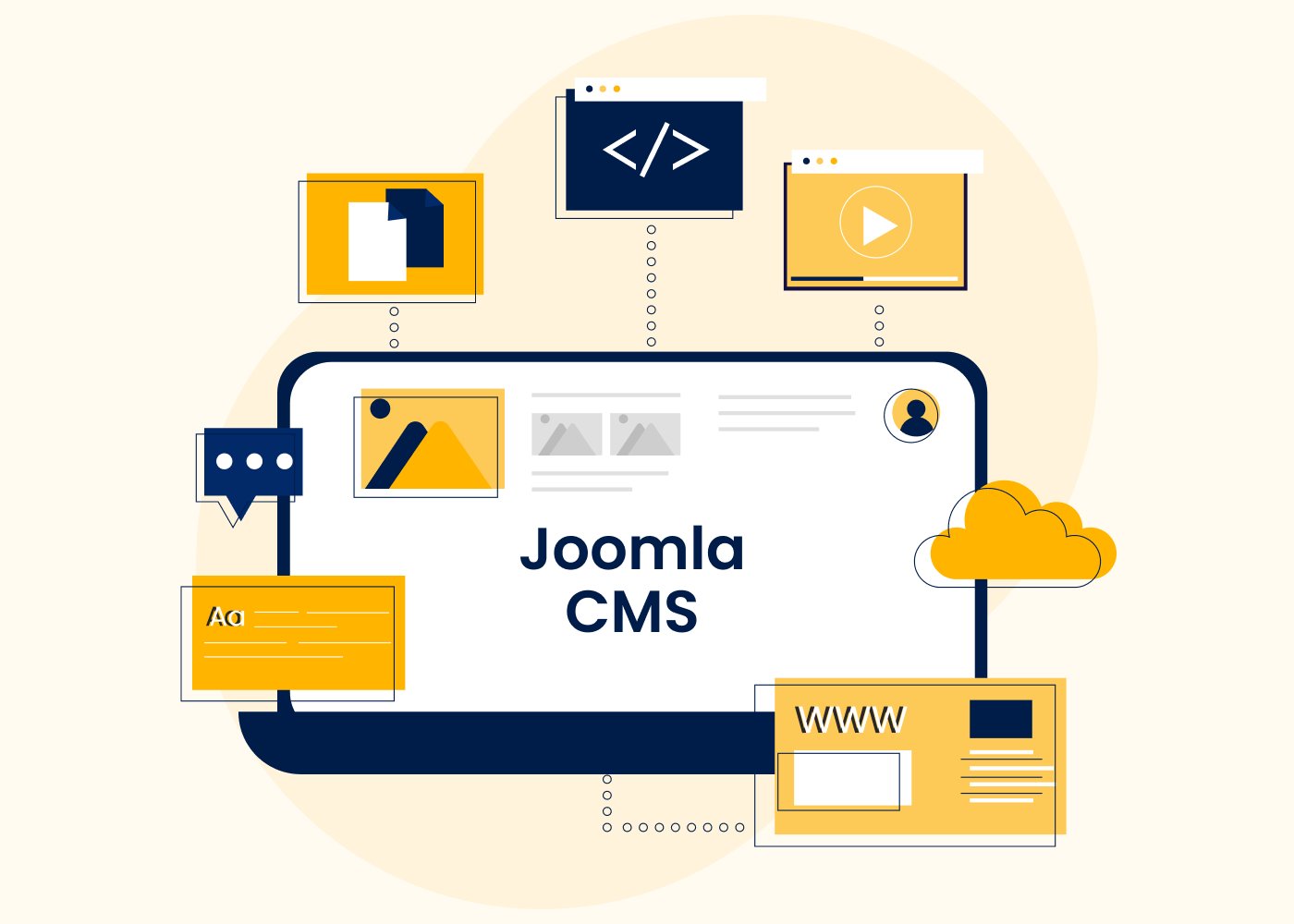What is Joomla?
Written in PHP, Joomla is a powerful content management system that is used by millions of websites all over the world. It is an open-source CMS that helps develop websites and web applications. It is free to use. It makes use of the MySQL database to store content. Joomla is delivered under the General Public License. You can create all kinds of websites with Joomla such as - corporate websites, e-commerce websites, government websites, Booking portals, etc. All these dynamic websites can be well-managed with sophisticated features in Joomla.
What's a content management system (CMS)?
A content management system (CMS) is a computer system software that helps users create, organize, edit, and publish content. This content can be in the form of text, documents, photos, music, videos, etc. CMS enables a user to publish and manage digital content from any location.
Why Choose Joomla for Your Website Project?
- The robust extension ecosystem in Joomla offers a wide range of extensions (plugins, modules, and components). This makes the functionality of a Joomla website better.
- The admin dashboard in Joomla is organized and intuitive.
- Being an open-source platform, Joomla is freely available for anyone to use.
- It allows administrators to create and manage user groups with specific permissions. This is beneficial for websites with multiple contributors or different access levels.
- Multi-lingual support feature in Joomla makes it beneficial for businesses targeting a global audience.
- A supportive community of developers and users is available for Joomla if you get stuck.
- Concerning security, Joomla includes features like two-factor authentication, SSL/TLS support, and regular security updates.
- Joomla supports e-commerce functionality through extensions like VirtueMart and HikaShop, allowing users to create online stores with various features and payment gateways.
- Joomla is a great choice for larger and more complex websites that require advanced features and customization.
- Joomla offers an edge to e-commerce companies with special features and tools designed for e-commerce applications. Also, third-party integrations help build the ability to incorporate payment gateways, checkout services, shipping and inventory, and product management.
History of Joomla
Joomla is based on Mambo CMS. Mambo CMS was developed by an Australian company in 2001. Since its official release on September 22, 2005, the project has evolved with the following versions:
- Joomla 1.0
- Joomla 1.5
- Joomla 1.6
- Joomla 1.7
- Joomla 2.5
- Joomla 3.0
- Joomla 3.1
- Joomla 3.2
- Joomla 3.3
- Joomla 3.4
- Joomla 3.5
- Joomla 3.6
- Joomla 3.7
- Joomla 3.8
- Joomla 3.9
- Joomla 3.10
- Joomla 4.1
- Joomla 4.2
- Joomla 4.3
- Joomla 4.4
- Joomla 4.5
- Joomla 4.6
Where to download Joomla
You can download the latest version of Joomla directly from Joomla.org . You can download the extensions as well from the same portal at https://extensions.joomla.org/.
Requirements of Joomla
The current version of Joomla Release 4 needs the following requirements:
PHP version:
- 7.2.5 (Minimum).
- 8.0 (recommended).
Database:
- MySQL 5.6 or higher.
- PostgreSQL 11.0 or higher.
Web server:
- Apache 2.4 or higher.
- Nginx 1.18 or higher.
- Microsoft IIS 10 or higher.
What Are Joomla Extensions And Their Development Process?
Joomla heavily depends on extensions to enhance its core functionalities and offer extra capabilities. These extensions are vital in shaping the functionality, customization, and overall strength of a Joomla website. Joomla encompasses a range of extension types, such as components, modules, plugins, and templates. However, before delving into the development process of Joomla Extensions, it is imperative to comprehensively grasp the individual significance and role of each extension in a Joomla website.
What Are Components?
- Components are the main functional units in Joomla. They represent major application areas and typically have their views, controllers, and models. Components provide the core functionality of a website. With the help of these, we can have various sections on a website. A newsletter is an example of a component. It has its database and functionality. A component is a stand-alone application.
- To create a component, you need to define the component's structure, including database tables, views, controllers, and models.
- Use PHP, XML, and other web technologies to develop the component's functionality.
What Are Modules?
- Modules in Joomla are lightweight extensions that can be positioned around the main component area of a webpage. They serve specific purposes, such as displaying a login form, showing recent articles, presenting a menu, or incorporating custom HTML content. The menus you see on the front end are displayed within modules which is why you can have as many as required. The information that is provided by Modules is already present on the website. You can view as many modules on a single page as is required. This can add a new function to an application, which was already part of your Joomla website.
- Develop a module by creating PHP files and defining parameters and settings in XML files.
- Modules can include custom HTML, CSS, and JavaScript to control their appearance and behavior.
What Are Plugins?
- Plugins are event handlers that respond to specific events triggered during the Joomla execution lifecycle. Plugins can also extend and or modify the core system providing overrides to templates, classes, and functions. The Joomla contact form is a good example that enables us to create or eliminate additional fields on the fly. We can then create another plugin that provides a custom reply to add HTML templates, signatures, and so on so when someone visits the default Joomla contact form they will be presented with a customs form with custom fields and then on submission the form is validated and email is sent as a template html email. Plugins are implemented before the page is loaded, in most cases. Plugins operate behind the scenes and can do a multitude of things, like replacing content with other content, performing searches, performing login/logout functions, or anything really tricky that you can imagine.
- Create plugins to extend Joomla's functionality by responding to events like content creation, user login, or system initialization.
- Use PHP to define the plugin's behavior and XML for configuration settings.
What Are Templates?
- Templates control the overall layout and design of a Joomla website.
- Develop a template by creating HTML, CSS, and PHP files. XML files are used to define metadata and configuration options.
- Templates define the structure of the website, including the header, footer, and positions for modules.
How to Develop a Joomla Extension?
Developing Joomla Extensions involves creating custom features or functionalities that can be integrated into a Joomla website. For a better understanding, let’s dig deeper into the process of developing a Joomla extension:
1. Set Up a Development Environment:
- Install a local server environment (e.g., XAMPP, Wamp Server) on your computer for Joomla development. Download and install Joomla on your local server.
2. Understand Joomla Structure:
- Familiarize yourself with Joomla's structure, including the file organization, MVC (Model-View-Controller) architecture, and extension types.
3. Choose Extension Type:
- Decide whether you want to create a component, module, plugin, or template based on the functionality you want to add.
4. Create Extension Files:
- Develop the necessary PHP, XML, HTML, CSS, and JavaScript files for your extension. Follow Joomla coding standards and best practices.
5. Define Database Structure (if applicable):
- If your extension involves database interaction (e.g., for components), define the database tables and structure. Use Joomla's database classes for database operations.
6. Implement Functionality:
- Write the PHP code to implement the desired functionality for your extension. Utilize Joomla's API and libraries for common tasks.
7. Handle Permissions and Security:
- Implement access control and permissions based on Joomla's ACL (Access Control List) system. Ensure your Joomla Extension follows security best practices to prevent vulnerabilities.
8. Create Configuration Files:
- Define configuration options for your extension using XML files. This allows users to configure the extension through Joomla's administrator interface.
9. Test Extensively:
- Test your extension thoroughly on various browsers and Joomla versions. Check for compatibility with other extensions.
10. Document Your Extension:
- Provide comprehensive documentation for your extension, including installation instructions, configuration options, and usage guidelines.
11. Package Your Extension:
- Package your extension into a ZIP file according to the Joomla Extension package structure. Include the necessary manifest files and assets.
12. Submit to Joomla Extension Directory (Optional):
- If you wish to share your extension with the Joomla community, consider submitting it to the Joomla Extension Directory (JED).
In summary, extensions are fundamental to the success of a Joomla website, providing the means to enhance functionality, customize the user experience, and stay current with evolving web trends and technologies.
Remember to refer to the official Joomla documentation, coding standards, and developer resources for detailed information and best practices throughout the Joomla development process.
Navigating the System Dashboard:
The Control Panel has all the default functions and features that are there in Joomla. These are accessible through menu bars, icons, etc. When we go to the Joomla Administrative Panel, you can see these important icons and their specific functions. The following screen will be in front of you as you open the control panel:
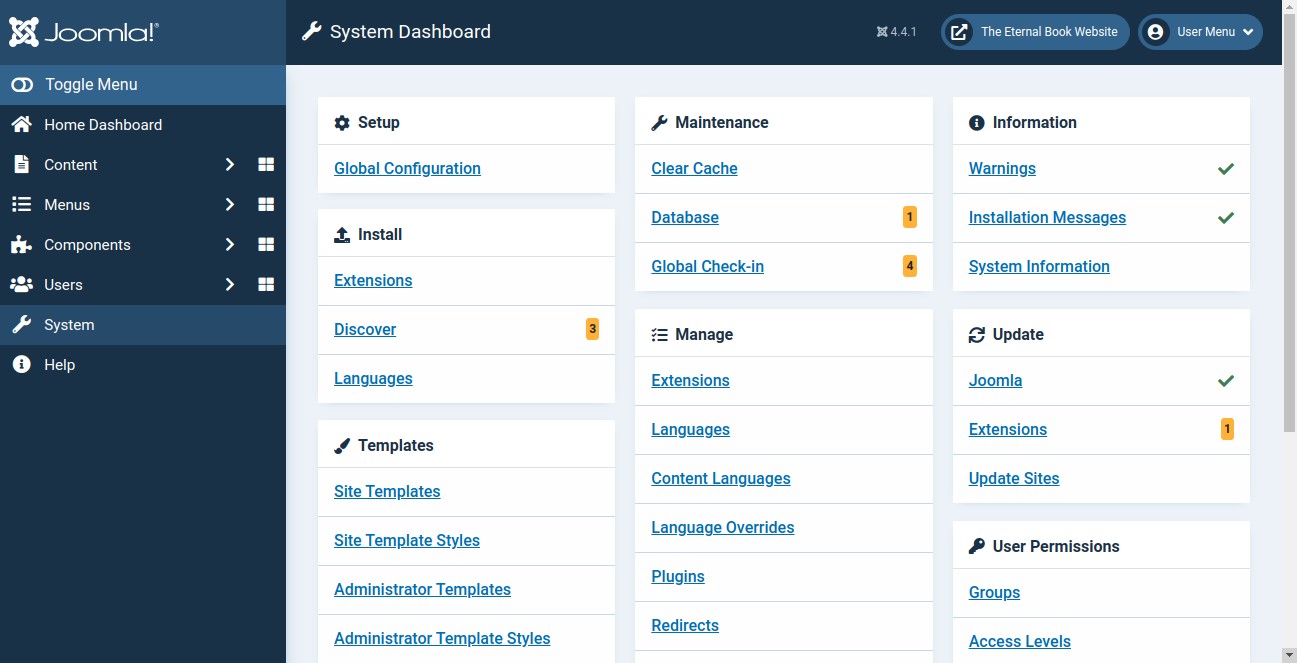
Security Aspect in Joomla:
Mostly the vulnerabilities of the CMS depend on the third-party extensions. You should give extra focus to the extensions that are being used. Enable two-factor authentication along with a secure password.
When discussing Joomla, it is crucial to be mindful of the plugins and nulled themes, just like we have observed with WordPress. Paying attention to the extensions we utilize on our website is of utmost importance.
Joomla compiles a catalog of susceptible extensions and provides patches to address them. In cases where patches are unavailable, it is recommended to uninstall these potentially hazardous extensions from the site.
In terms of access, apart from employing a strong password, you can also activate two-factor authentication. Additionally, within the CMS settings, there is an option to enforce HTTPS and consequently employ a secure protocol.
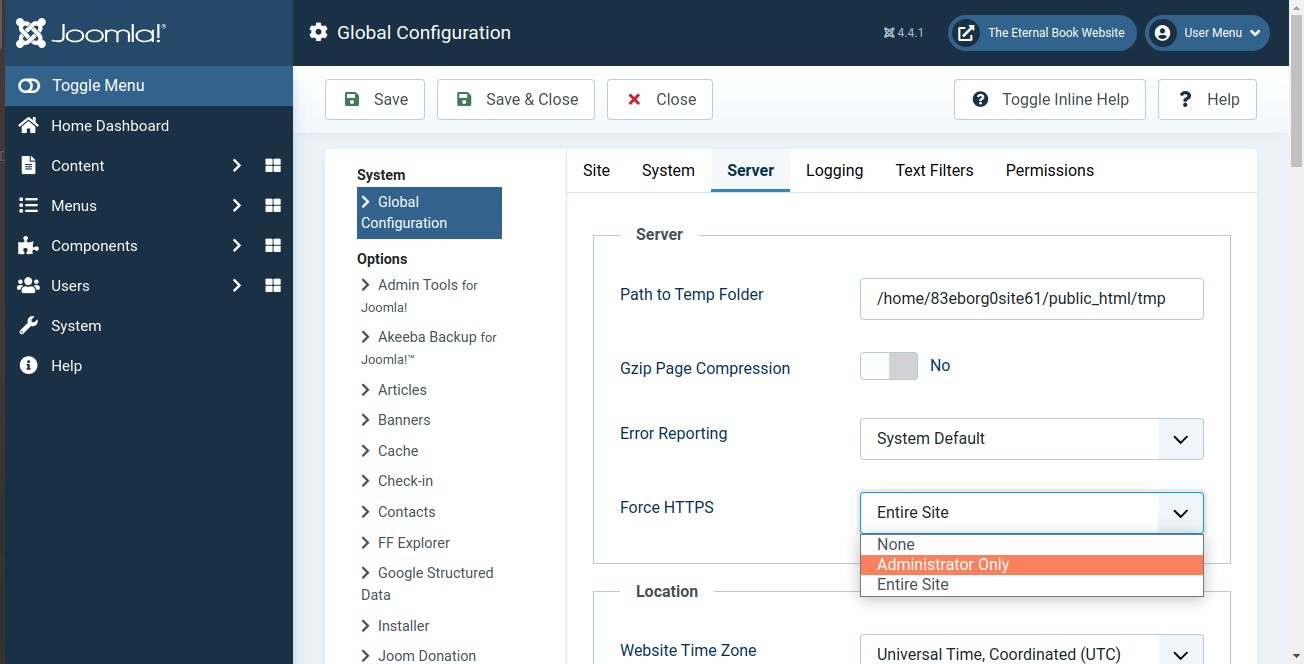
Built-In SEO Capacity:
Joomla provides us with the ability to enhance the SEO of our website. We have the flexibility to personalize the title tag and Meta description for each page, as well as utilize SEO-friendly URLs.
Furthermore, with the help of extensions, we can easily generate a sitemap for our site.
Additionally, a system plugin allows us to efficiently manage redirects. We have the option to configure individual 301 redirects or import multiple redirects simultaneously.
Unique Multiple-language Feature
The multiple-language feature in Joomla, often referred to as multilingual support, provides a range of benefits for website administrators and users aiming to create content that caters to diverse linguistic audiences. Here are the key advantages of the multiple language feature in Joomla:
1. Global Reach:
- Multilingual support allows websites to reach a global audience by presenting content in multiple languages. This is essential for businesses, organizations, or individuals targeting users from different regions around the world.
2. Audience Inclusivity:
- Providing content in multiple languages ensures inclusivity, making the website accessible and welcoming to users who speak different languages. It helps remove language barriers and enhances the user experience for a broader audience.
3. Internationalization and Localization:
- Joomla's multilingual features support both internationalization (providing content for a global audience) and localization (adapting content for specific regions or cultures). This flexibility is crucial for adapting the website to diverse linguistic and cultural contexts.
4. Content Tailoring:
- Administrators can tailor content for specific language groups, taking into account cultural nuances, preferences, and regional variations. This allows for a more personalized and relevant experience for users in different language communities.
5. Search Engine Optimization (SEO):
- Multilingual websites can benefit from improved SEO by targeting keywords in multiple languages. This enhances the visibility of the website in search engine results pages across different language markets.
6. Increased Engagement:
- By offering content in users' preferred languages, websites are more likely to engage and retain visitors. Users are more likely to stay on a site and interact with its content when it is presented in a language they understand.
7. Translations and Language Overrides:
- Administrators can easily manage translations of content and interface elements through the Joomla language manager. Additionally, language overrides allow customization of specific terms or phrases for different languages without altering the core code.
The multiple-language feature in Joomla promotes inclusivity, global reach, and an enhanced user experience by facilitating the creation of multilingual websites. This is particularly valuable for businesses, organizations, or individuals seeking to connect with diverse audiences and expand their online presence internationally.
Styling the Joomla Website through Templates:
Joomla offers two categories of templates: site templates, which enable us to modify the visual design of the front-end, and back-end templates. In Joomla 4.0, the default template for the front end is Cassiopeia.
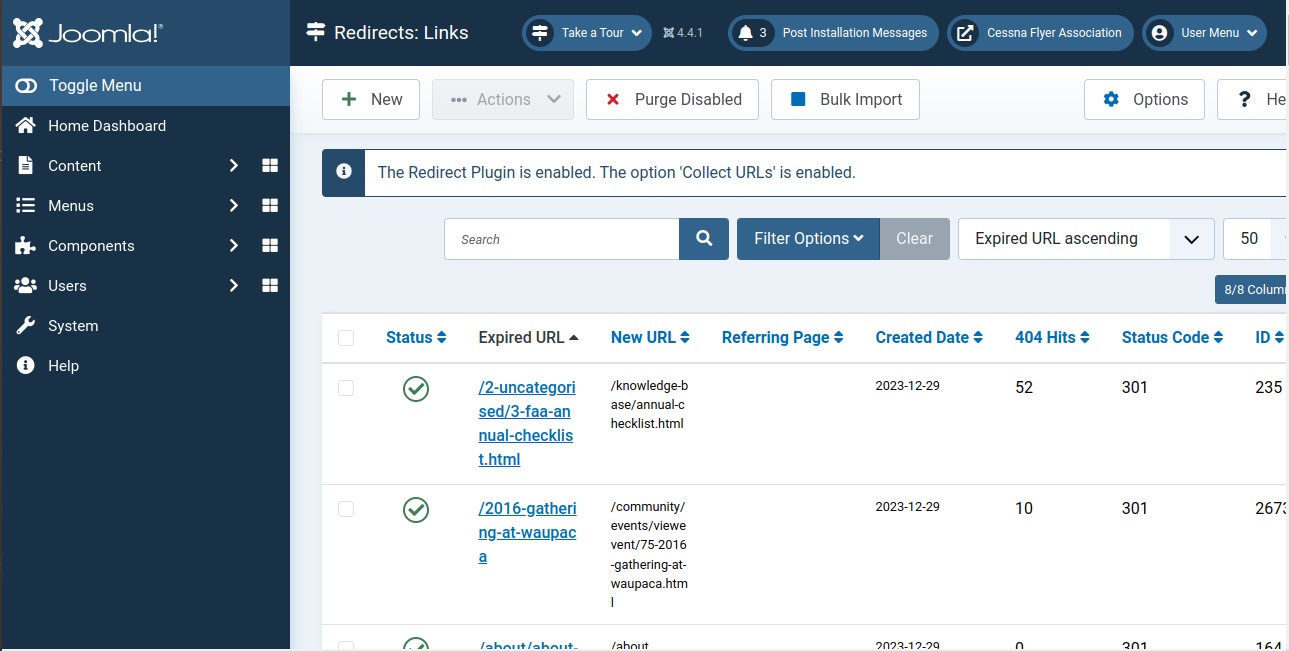
It is possible to install additional templates or make modifications to the default template. Furthermore, it is also feasible to create a personalized template. Joomla provides the option of template override, which enables us to make alterations to the existing template. This ensures that our modifications will be retained when updating the CMS.
Similar to the WordPress Child theme, template override in Joomla allows for theme modifications to be preserved even after updating the current theme. Additionally, it is possible to create pages with different layouts from the standard layout used across the entire site.
Structure of the Website in Joomla:
Joomla, like many modern web applications, uses the Model-View-Controller (MVC) architectural pattern to organize and structure its code. The MVC pattern helps separate the concerns of data manipulation, user interface, and application logic, making the code more modular and maintainable. Here's an overview of how MVC is implemented in Joomla:
1. Model:
The Model represents the application's data and business logic.
- Implementation in Joomla:
- - In Joomla, the Model is responsible for managing and manipulating data, often interacting with the database.
- - Models in Joomla are located in the models' directory and typically extend the JModelBase class.
- - They handle tasks such as retrieving, saving, updating, and deleting data from the database.
- - Models are associated with specific components or views within the Joomla application.
2. View:
The View is responsible for presenting the data to the user and handling user interface elements.
- Implementation in Joomla:
- - Views in Joomla are responsible for rendering HTML output and presenting data to users.
- - They are located in the views directory and typically extend the JViewLegacy class.
- - Joomla views use layout files to separate the HTML structure from the PHP code.
- - Views may also handle user input, but complex logic is usually delegated to the Controller.
3. Controller:
The Controller processes user input, interacts with the Model, and updates the View accordingly.
- Implementation in Joomla:
- - Controllers in Joomla handle user input, process requests, and interact with models to retrieve or update data.
- - They are located in the controllers' directory and typically extend the JControllerLegacy class.
- - Controllers in Joomla often have methods corresponding to different actions or tasks within the component.
- - They act as intermediaries between user interactions, data manipulation (handled by the Model), and rendering (handled by the View).
This separation of concerns in Joomla's MVC architecture helps developers maintain a clean and organized codebase, making it easier to manage and extend Joomla components. It also supports better collaboration among developers working on different aspects of the application.
How to Manage User Permissions in Joomla?
Access Control List (ACL) in Joomla is a powerful feature that provides a flexible and granular way to control user permissions and access to various aspects of a Joomla website. Here are the key benefits of using ACL in Joomla:
1. Specific User Permissions:
- ACL in Joomla allows administrators to define specific permissions for different user groups. This granular control enables fine-tuning of what actions each user group can perform on the website.
2. Multiple User Groups:
- Joomla supports the creation of multiple user groups, each with its own set of permissions. This allows for the categorization of users based on their roles or responsibilities on the website.
3. Flexible Content Control:
- With ACL, administrators can control who can view, create, edit, publish, or delete content. This includes articles, categories, and other content types on the Joomla website.
4. Custom Access Levels:
- Joomla provides the ability to create custom access levels, allowing administrators to define more specific access rules. This is useful for scenarios where standard user groups and permissions are not sufficient.
5. Module and Menu Item Permissions:
- ACL extends to modules and menu items, enabling administrators to control which modules or menu items are visible to specific user groups. It helps in creating personalized user experiences.
6. Component-Level Permissions:
- Components in Joomla (e.g., extensions, plugins) can have their own ACL settings. This means administrators can set permissions for specific components, granting or restricting access as needed.
7. Control Over Administration Features:
- ACL allows administrators to control access to the Joomla administration area. This ensures that only authorized users can access and modify the site's configuration and settings.
8. Improved Security:
- By limiting access to certain areas of the website, ACL helps enhance security. It reduces the risk of unauthorized users making changes that could compromise the integrity of the site.
9. Multilingual Support:
- Joomla's ACL includes support for multilingual websites, allowing administrators to manage permissions for different language versions independently.
10. User Management:
- Administrators can control user registration, activation, and management processes. ACL allows specifying who can register, activate accounts, or have specific user management privileges.
11. Audit Trails:
- Joomla keeps track of changes made by users, making it easier to audit and review actions taken on the website. This can be helpful for troubleshooting and accountability.
12. Scalability and Flexibility:
- ACL provides a scalable solution for websites of varying sizes and complexity. Whether managing a small blog or a large corporate site, administrators can tailor permissions to suit the specific needs of the Joomla instance.
13. Community Extensions Compatibility:
- Many third-party extensions for Joomla are built to integrate seamlessly with the Joomla ACL system. This ensures that the benefits of ACL can be extended to a wide range of functionalities beyond the core Joomla features.
In summary, ACL in Joomla offers administrators the tools needed to manage user access with precision, enhancing security, user experience, and overall control over the website's functionality. It's a valuable feature for websites with diverse content, multiple user roles, and varying access requirements
Managing Content in Joomla:
Managing content in Joomla comes with various benefits, making it a popular choice for websites ranging from blogs and small business sites to large corporate portals. Here are some key benefits of managing content in Joomla:
1. User-Friendly Content Editor:
- Joomla provides a user-friendly content editor that allows users, even those without extensive technical knowledge, to create and edit content easily. The WYSIWYG (What You See Is What You Get) editor simplifies the content creation process.
2. Flexible Content Types:
- Joomla supports various content types, including articles, categories, tags, and custom fields. This flexibility allows website administrators to organize and present content in a way that suits their specific needs.
3. Structured Content Management:
- Content in Joomla is organized in a structured manner using categories. This hierarchical organization makes it easier to manage and navigate through content, especially on websites with a large volume of articles.
4. Customizable Templates:
- Joomla allows users to create and apply custom templates to control the visual presentation of content. This ensures a consistent and professional look across the website.
5. Multilingual Support:
- Joomla provides built-in multilingual support, allowing content to be presented in multiple languages. This is particularly beneficial for websites targeting diverse audiences and global markets.
6. Version Control:
- Joomla keeps track of content revisions, allowing users to revert to previous versions if needed. This version control feature is useful for content collaboration and mitigating the risk of accidental changes.
7. Media Manager:
- The Media Manager in Joomla facilitates the management of images, documents, and other media files. It provides an organized structure for storing and accessing media assets used in content.
8. Content Tagging:
- Joomla supports content tagging, allowing administrators to assign tags to articles. Tags enhance content discoverability and can be used to create tag-based navigation and filtering.
9. Integrated SEO Features:
- Joomla includes built-in SEO features that enable administrators to optimize content for search engines. This includes customizable Meta tags, friendly URLs, and other SEO-friendly elements.
10. User Access Control:
- Joomla's Access Control List (ACL) allows administrators to control user access to content. Different user groups can be assigned specific permissions, ensuring that only authorized users can view or edit certain content.
11. Social Media Integration:
- Joomla integrates with social media platforms, making it easy to share content on social networks. This helps increase the reach and visibility of the website's content.
What Kinds of Websites Can Be Created with Joomla?
Joomla is a versatile platform that caters to various types of websites. It is suitable for small business sites, online magazines, e-commerce platforms, personal websites, government agency sites, as well as web portals for schools, communities, and nonprofit organizations.
In the year 2021, Joomla was honored with multiple accolades at the CMS Critic People's Choice Awards, where it was recognized as the top open-source CMS and the finest free CMS available.
- E-commerce and online reservations
- Government applications
- Small business websites
- Non-profit and organizational websites
- Corporate websites or portals
- Corporate intranets and extranets
- Online magazines, newspapers, and publications
- Community-based portals
- School and religious websites
- Personal or family homepages
Upgrade within Joomla:
In addition to ensuring software compatibility and safeguarding against vulnerabilities, updating to a new version of Joomla presents a multitude of benefits. It is imperative to familiarize yourself with the numerous features that await you and the advantages they bring. Among these are streamlined workflows that enhance team productivity and revamped functions that facilitate website management.
Upgrade Checklist
Before proceeding to the update phase, it is advisable to conduct a thorough examination of all extensions and consult the developer websites to ascertain if a newer version is accessible.
Moving forward, have you or any other developer developed any personalized modules or components? The primary disparity between Joomla versions lies in the class names employed, but modifications will be necessary for the custom code to function in the updated version.
Considerations:
- Extensions, plugins, and packages
- Compatibility with templates
- Custom-developed extensions
- Server capability, such as the PHP version
- Minimum requirements for Joomla 4
- Are you using shared web hosting? Can other sites run on the same PHP version?
- Are the same modules enabled in the new PHP version?
Make Backups
It is highly recommended to regularly create backups of your progress to safeguard against any unforeseen circumstances. This way, in the event of any unfortunate incidents, you can easily restore your upgrade to the most recent successful point instead of starting from the beginning.
Moreover, it is of utmost importance to have a backup version of the live site before implementing any changes. This ensures that you can revert if needed, providing an added layer of security.
Pre-Update Checks
Any extensions that require attention are identified as "Potential Upgrade Issues," and it is recommended to further investigate these items on the developers' websites before proceeding. It is advisable to perform this pre-audit check on a staging version, as it allows you to start over without affecting your live site in case any issues arise.
If you do not see the latest Joomla Update when accessing Components > Joomla Update, simply select Joomla Next as the Update Channel from the Options menu.
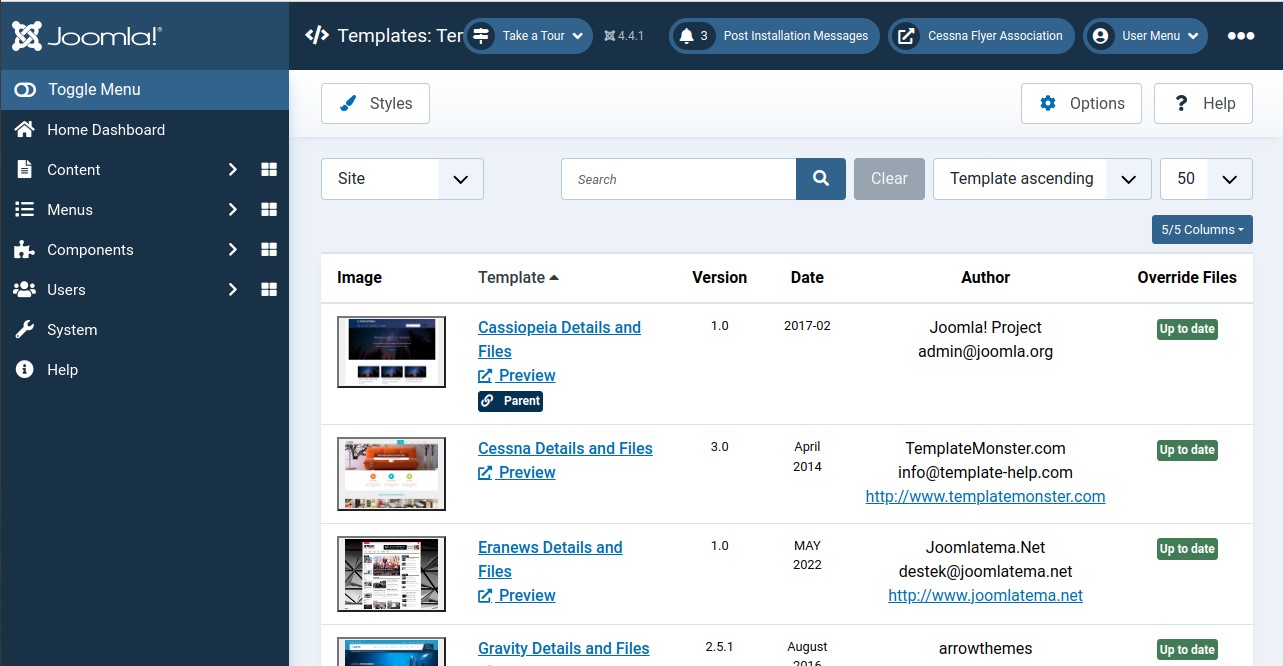
It is crucial to ensure that you are connecting to the correct database during this stage. Once you have completed all the necessary checks and are satisfied with the outcome, navigate to the Live Update tab and carefully review any remaining warnings.
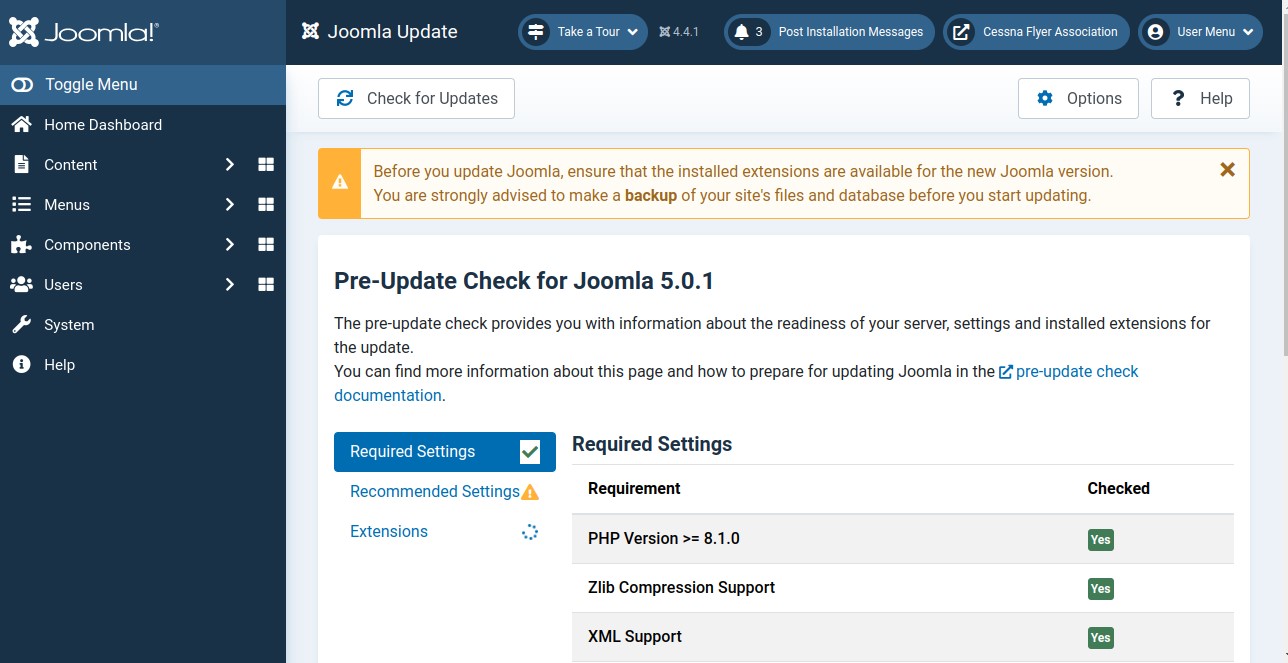
Re-enable and Update Extensions
Before activating extensions on your upgraded site, it is important to update them if necessary. Additionally, keep an eye out for any other extension updates that may appear, and make sure to check Discover as well. To ensure everything is in order, it is recommended to review the System area for any links that have a number next to them.
Joomla 5
This guide won’t be complete without discussing a bit about Joomla 5 which was announced on November 28, 2023. It has some great new features, improvements, and enhancements.
If you want to learn more about Joomla 5 benefits, then visit joomla.org/5.
Improvements and New Features in Joomla 5
- Improved User Interface
- Plugins Updates
- Better Media Management
- Menu Sorting is Flexible
- Improved Security Features
- Modern Technologies and APIs
- Dark Mode in Administrator
- Web Assets and Caching Improvements
- Extensions and Compatibility
- Schema.org Incorporation for SEO
- Code Optimization through phpcs fixer
- PHP and Bootstrap Updates
- Smoother and Cleaner Code Base
For a step-by-step upgrade to Joomla 5, check https://docs.joomla.org/Joomla_4.4.x_to_5.x_Planning_and_Upgrade_Step_by_Step.
As per Joomla.org, “Planning is the most important part of this upgrade”.
Migration from WordPress to Joomla:
Before we begin, it is important to note the following information:
- When importing categories from WordPress to Joomla, the imported posts/pages will not be associated with their corresponding categories. This is because WordPress allows one post to be associated with multiple categories, whereas Joomla does not.
- All WordPress categories and sub-categories will be converted into categories in Joomla.
- WordPress uses the phpass algorithm to encrypt passwords, while Joomla uses MD5. As a result, login passwords imported from WordPress will not work in Joomla. To address this issue, you can install the WordPress "MD5 Password Hashes" plugin before importing. This plugin converts WordPress passwords into MD5, which Joomla can understand. You can find the plugin here: https://wordpress.org/extend/plugins/md5-password-hashes/
- The import process will only import your database and not files such as images. You have to move these files manually.
- If you have the JComments extension installed on your Joomla site, comments will also be imported.
Step 1 Install Joomla and the JConverter Extension
- Install a fresh copy of Joomla.
- Then find and download the JConverter extension for Joomla.
- Install JConvertor into your new Joomla site.
Step 2 Get Your WordPress Database Details
- Go into your WordPress files and access wp-config.php. Check the following details in the file:
- Database name
- Database user
- Database password
- Database host
- Database prefix
Step 3 Enter Your WordPress Database Details
- In your Joomla site, go to Extensions > JConvertor > Configuration and enter the collected database information.
- Go to the Select Import Options group of settings and select them according to your preference.
Step 4 Start the Conversion
- After making sure that data is in place, click Save and then click Start Conversion.
Migrating a website from WordPress to Joomla can be a complex undertaking, but there are various add-ons available for the CMS that can help simplify the process. The choice of solution will largely depend on your budget and level of expertise.
For Joomla users looking to migrate website content, categories, comments, users, and passwords seamlessly, it is recommended to consider using the JConverter, CMS2CMS, or CMigrator extensions. These add-ons are highly popular within the Joomla community and ensure data integrity and compatibility throughout the migration process.
Alternatively, if you have a smaller site and do not require user data transfer, you can explore options such as exporting MySQL tables to CSV files or performing a manual data transfer.
While these methods may be suitable for simpler migrations, they do not include user data transfer. In this article, we will discuss five different methods for migrating CMS content from WordPress to Joomla, highlighting the advantages and disadvantages of each approach.
By considering these options, you can make an informed decision based on your specific requirements and resources. One of the most widely used free migration solutions for transferring WordPress to Joomla is JConverter. This service supports Joomla 3.x conversions and is a popular choice among users.
Additionally, there are other free options available, such as exporting MySQL tables or converting them to CSV format, as well as manually transferring site content. The decision between free and paid migration solutions for Joomla will depend on your budget for third-party software subscriptions and add-ons. Continue reading to explore the various methods and determine the best approach for your WordPress to Joomla migration.
1. JConverter Extension (Free)
This is one of the best solutions for migration to Joomla from WordPress.
To use the JConverter extension:
- Install Joomla 4 on your web server.
- Download the JConverter extension from the official website.
- Install the JConverter extension in the Joomla CMS.
- Navigate to Extensions > JConverter > Configuration.
- Enter the hostname, user, and password for the WordPress database.
- Choose which files and data to import from the WordPress website.
- Click “Start Conversion” and wait for the data to transfer.
- Manually test if all data was properly transferred.
The JConverter extension can be connected to the WordPress database directly. You will get a confirmation report of the files after the import of the information.
Do a manual comparison of the data to ensure total file transfer. The next step is to install a new Joomla template. Now you can start to rebuild your website.
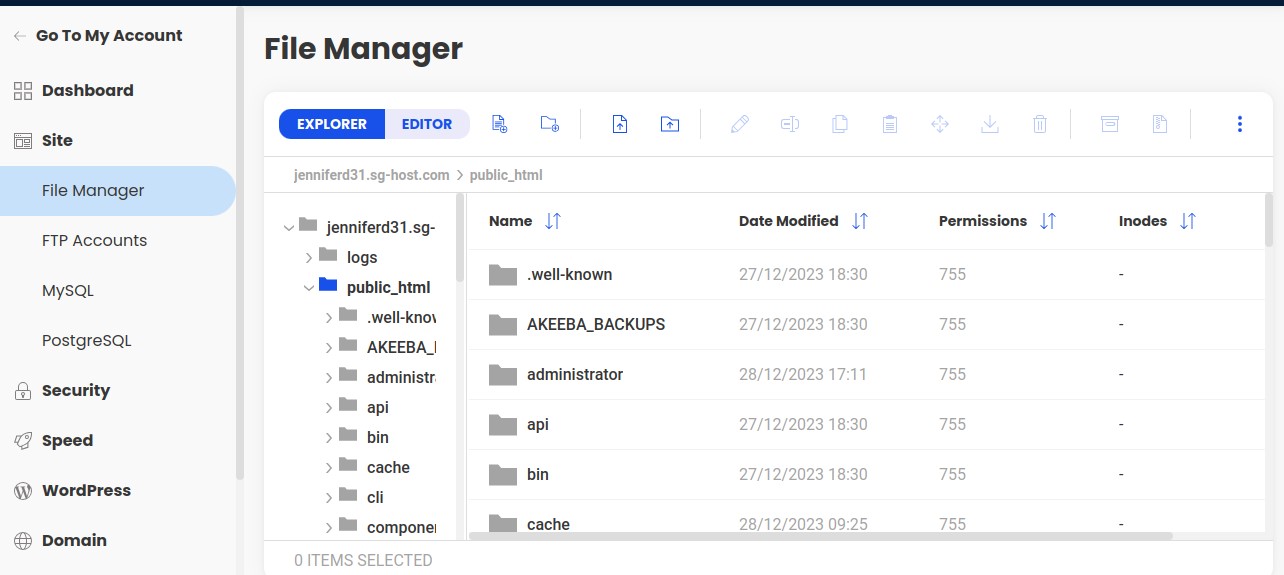
2. CMS2CMS Extension (Paid)
The CMS2CMS extension is also a good way for the migration from WordPress to Joomla.
To use the CMS2CMS extension for Joomla:
- Install a new Joomla 4 website.
- Download and install the CMS2CMS extension in Joomla admin.
- In the Components section, choose ‘CMS2CMS: WordPress to Joomla Automated Migration’.
- Sign up for an account with the publisher.
- Enter the WordPress URL in the Connector Bridge.
- Input the FTP host, username, and password for file transfers.
- Click “Proceed”.
- View the settings on the CMS2CMS page with the estimated cost of migration.
- Pay the required fees and complete the migration.
Even though it can be an expensive option, users prefer it for its data compatibility and better content support.
Migration from Blogger, Drupal, Joomla, TYPO3, Vbulletin, WordPress, SMF, Weebly, and Wix are supported by CMS2CMS.
3. CMigrator Extension (Paid)
The CMigrator extension is another reliable choice for migrating a WordPress website to Joomla 4. With a single-year subscription having an economic price, CMigrator is more cost-effective than CMS2CMS. This extension allows you to install it on unlimited websites and seamlessly transfer data from both WordPress and Drupal to the Joomla CMS for republishing.
CMigrator is capable of importing various elements such as content, tags, Meta keywords, comments, users, and passwords to Joomla without requiring any additional WordPress plugins. However, to ensure comment compatibility, it is necessary to install the CComment extension in Joomla 4.
One of CMigrator's strengths lies in its ability to handle large database transfers, making it an ideal choice for websites with extensive content.
Additionally, the subscription includes full customer support, further enhancing the reliability of the service. Many users consider CMigrator to be a cost-effective alternative to JConverter for upgrading their websites.
To use the CMigrator extension:
- Install a new Joomla 4 website with a MySQL-compatible database.
- Download the CMigrator extension from the official website.
- Install the CMigrator extension in the Joomla admin section.
- Confirm or update to the latest version as prompted by the script.
- Navigate to the CMigrator Control Panel.
- Create a Migration Configuration to import the types of content required.
- Enter the database prefix for the WordPress website.
- Login to phpMyAdmin and export the tables of the WordPress website.
- Import the tables into Joomla using phpMyAdmin.
- Click on “Migrate” in the Control Panel to complete the conversion.
- Manually verify the transfer.
4. Other Methods: MySQL Table Export
An alternative approach to converting WordPress to Joomla is to manually export the database using phpMyAdmin, without relying on any plugins. This method is particularly suitable for small websites and users with limited budgets, as it eliminates the need to spend a significant amount of money on extension subscriptions or website transfers during the migration process.
However, it should be noted that this method requires a higher level of developer skills compared to other methods. To import data from Excel or CSV files, you can utilize the Community Builder User Import plugin for Joomla. By accessing phpMyAdmin on your WordPress website, you can export content tables and transfer them using this method.
Additionally, the JomSocial User Import extension, developed by the same team, can also handle this functionality securely, allowing you to import WordPress data. It is important to mention that the process of exporting MySQL tables and converting them to CSV files is complex and not entirely reliable for complete site transfers, including tags, menus, categories, users, and passwords.
5. Other Methods: Manual Data Transfer
If your website has less than 100 pages of content and only the admin account is registered on WordPress, you can attempt a manual data transfer between sites. For websites that have a menu, contact form, e-commerce catalog, and promotional content, you can simply recreate the WordPress site in Joomla using stock extensions and manually transfer the content.
This approach eliminates the need for premium plugins, database exports, or subscription plans. However, it may not be efficient for large websites with extensive content or multiple user accounts. In such cases, most publishers find it more time and cost-effective to use JConverter instead. It is advisable to consider manual data transfer as a last resort and rely on it primarily for verifying your migrations.
6. Common Problems & Solutions
Managing the settings for Joomla database parameters through phpMyAdmin is the most common issue encountered during WP conversions. This problem can be overcome by using plugin solutions, which facilitate the transfer of users, passwords, and hashes.
Relying solely on phpMyAdmin database table exports can make this process challenging. Another challenge is preserving the site URLs and ensuring their proper conversion. JConverter, CMS2CMS, and CMigrator are tools that offer options to address this concern when converting WP sites to Joomla. These tools also assist with the migration of tags and menus.
Unfortunately, there are no straightforward solutions for converting WordPress themes to Joomla. The CSS code from the original theme needs to be manually ported to the Joomla template.
It is important to note that a new WordPress site offers a wider range of options for plugins and themes compared to Joomla. If you are considering converting your site from WordPress to Joomla, it is highly recommended to hire an experienced front-end developer who can rebuild the theme and replicate the original design of your WordPress site in Joomla.
When it comes to WordPress to Joomla migrations, CMS2CMS is considered the most professional solution. However, it may be expensive for some projects. CMS2CMS has a large user base and supports the most features for data preservation during transfers. On the other hand, the J Converter extension is a simple, powerful, and free option for migration. However, it does not cover the full range of data settings.
Nevertheless, the database connection provided by J Converter is efficient for most website conversions and does not require a subscription fee. For those looking for a middle-range option, C Migrator is available. It is cheaper than CMS2CMS but not as extensive and more complex to use. Users may find the requirements to access phpMyAdmin for exporting WordPress database tables and reimporting them on another host for Joomla to be daunting.
Final Notes:
After thoroughly discussing all aspects of Joomla, it is evident that Joomla possesses a robust extension ecosystem. These extensions cover a wide range of areas such as In Built SEO, e-commerce, social media integration, and more.
Additionally, Joomla provides advanced user management features that enable administrators to create and manage user groups with specific permissions. This proves to be highly advantageous for websites with multiple contributors or varying access levels.
Furthermore, Joomla boasts built-in multilingual support, making it an ideal choice for creating websites in multiple languages. This particular feature is particularly beneficial for businesses that aim to target a global audience.
Lastly, Joomla's scalability is worth mentioning. Its flexibility allows it to cater to a variety of projects, ranging from personal blogs to corporate websites and e-commerce platforms, and many more.
 08 January 2024
08 January 2024 08 January 2024
08 January 2024